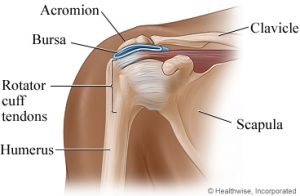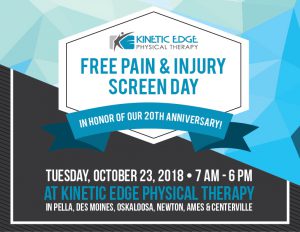Shoulder Potpourri: Everything You Wanted to Know About Shoulder Problems
by Dr. Troy Vander Molen, PT, DPT
I’m sure you’re not surprised to hear this: Shoulder pain is a common problem. Studies suggest that 70% of us will experience shoulder pain at some point in our lifetimes. It’s no wonder, because the shoulder joint is an extremely complex system.
The shoulder is one of the most mobile joints in the human body. It is a major link in the kinetic chain wherein the entire arm is connected to the rest of the skeletal system only by a very small joint between your collar bone and your chest.
This ball-and-socket joint is unique because the ball is large and the socket is small, kind of like a golf ball setting on a tee. Control of the ball on the tee requires very specific and fine actions by the rotator cuff muscles, which are relatively small and require appropriate, neutral postures to ensure they work efficiently.
Frankly, the shoulder is a source of job security for the physical therapists and movement experts at Kinetic Edge.
I reached out to a few friends this month to ask what they wanted to know about the shoulder joint, so this month’s article is a potpourri of information that will likely help you in one or more ways.
My shoulders are healthy. What exercises can I do to keep them that way?
First, I want to make an important point: We often equate lack of pain with health. If your shoulders don’t hurt, they must be healthy, right? Well, that’s not exactly true. Let me tell you why.
 When we think of the shoulder, we commonly picture the ball-and-socket joint, but the shoulder is really an entire complex that includes the collar bone (clavicle), shoulder blade (scapula), and upper arm bone (humerus). The health of shoulder is also directly impacted by neighboring areas including the neck (cervical spine), midback (thoracic spine), and rib cage.
When we think of the shoulder, we commonly picture the ball-and-socket joint, but the shoulder is really an entire complex that includes the collar bone (clavicle), shoulder blade (scapula), and upper arm bone (humerus). The health of shoulder is also directly impacted by neighboring areas including the neck (cervical spine), midback (thoracic spine), and rib cage.
Most shoulder problems occur because of muscle imbalances that place the shoulder complex in a position that reduces the efficiency of the rotator cuff muscles, which causes tissues in the system to experience increased mechanical stress (i.e. compression or tension forces). Muscle imbalances contribute to postural changes that make shoulder problems more likely to occur. Poor mobility of the mid-back and rib cage can lead to the same result.
A recent study looked at 379 participants with at least one rotator cuff tear. Only 2.9% of them had ideal shoulder alignment, while the remainder had forward head/rounded shoulders (65.8%), flat back (54.3%), or sway back (48.9%).
Often times people demonstrate these postures for years without any symptoms, but the presence of these postures – even without pain – indicates that your shoulders are not exactly healthy. They are at risk for future problems.
So, to make sure your shoulders are truly healthy, it is important for you to do exercises that help you maintain or restore muscle balance and allow for neutral shoulder positioning. It is extremely important to stretch the pectorals, upper traps, and suboccipital muscles, those most likely to get tight from gravity-induced postures. Furthermore, it is also very important to strengthen the upper back and shoulder blade muscles, those that are often ignored in our typical postures and work activities.
Stay tuned throughout the month of April as we’ll be posting video examples of how to stretch and strengthen these important muscles. And guys, it’s okay to work on your “mirror muscles”, but you should do so only if you’re willing to do maintenance with the aforementioned exercises.
What are some movements that the shoulder doesn’t really like?
Great question. In general terms, no joint appreciates the combination of end range motions with high speed and/or force. This is the reason why people experience shoulder injuries and pain, for example, when they slip and, in an attempt to avoid a painful fall, grab onto something, which suddenly jerks the shoulder into full elevation. That, of course, is something that happens naturally, so it’s difficult to avoid.
One of the most common regions of shoulder stress is in a small area called the subacromial space. If you place your fingers on the top edge of your shoulder, you’ll feel a portion of your shoulder blade called the acromion. Below that bone is a 5 mm interval called the subacromial space, through which run important rotator cuff tendons and, to reduce mechanical friction, a bursal sac.
Simply having muscle imbalances can increase mechanical compression on the rotator cuff tendons and bursa running through that space. For example, tight pectoral muscles pull the shoulder joint forward a bit, and those tissues are likely already experiencing increased pressure. Over time, this can cause cumulative trauma that eventually manifests as tendinitis, bursitis, or even rotator cuff tears.
The combination of shoulder elevation with internal rotation closes down the subacromial joint space and increases pressure on the tissues within it even further. It’s easier on those tissues to lift objects at arm’s length with the palm up, not down.
Have you ever experienced shoulder pain while lifting something out of your refrigerator? It’s likely you performed this movement with an extended arm and your palm down, a position that can increase stress on tissues within the subacromial space. So, instead of reaching, move your body forward to reduce the distance from your trunk to your hand when you reach, and keep your palm or thumb up. Your shoulder will definitely appreciate that habit over time.
If you have cumulative tissue changes already beginning in the subacromial space, you may wake up at night with shoulder pain from laying on your side, a position that increases pressure on the subacromial space. I realize that it’s difficult to prevent yourself from defaulting away from a favored sleeping position. You’re unconscious, of course. Nonetheless, it is less stressful on your shoulders to sleep on your back. If you wake up on your side, move to your back (and hope that your snoring doesn’t increase J).
I am experiencing shoulder pain. Can I continue doing shoulder exercises as long as they don’t cause pain?
I might be accused of copping out here, but… it depends.
You must recognize that there is a difference between discomfort and pain. If you recently began an exercise program, you know what delayed-onset muscle soreness feels like. It’s uncomfortable, but normal. You don’t have to avoid minor discomfort as long as it is the result of tissues accommodating to a new stress.
Pain, however, is a different beast, though it serves a noble purpose. Pain protects your tissues. If you were incapable of experiencing pain, you would likely experience higher levels of tissue damage from repeated stress, and you would also experience a more rapid and premature deterioration of function.
Therefore, if you experienced a recent injury (within the past month or so) and are actively experiencing shoulder pain, any motion that exacerbates the pain should be considered a warning signal. Avoid that motion. In this situation, it’s probably a good idea for you to consult with a physical therapist that understands the shoulder joint and can give you a personalized exercise plan to overcome this problem and allow you to continue being active without slowing up your progress.
If you have experienced shoulder pain for quite some time (6 weeks or more), you have reached the chronic phase. In this situation, it is generally acceptable to experience some shoulder pain during exercise, but it should be minor and go away within minutes of completing the exercise. If it is more significant or lingers for hours after exercise, that’s a good sign that you’ve slightly overdone it. Adjust your exercise volume downward next time.
If you’ve experienced shoulder pain for 6 weeks or more, you should definitely consult with a physical therapist. Solutions to these problems are generally pretty simple, and the earlier you get attention, the quicker it goes away.
But, what about the exercises that don’t cause pain? Well, they’re likely just fine for you. However, please review the answers I provided to the previous two questions to better understand what’s good for your shoulders and helps to enhance your shoulder health. Just because an exercise or motion doesn’t hurt your shoulder, it doesn’t necessarily mean that it’s good for you.
As I indicated in the introduction, shoulder pain is common. In fact, it’s the second most common problem among the many clients we serve in our five clinic locations.
 To thank our faithful customers for allowing us to survive and thrive for 20 years, we are offering a FREE SCREEN DAY on Tuesday, October 23, 2018. On that day, each of our clinics will have 33 slots available between 7:00 am and 6:00 pm for you, your family, and your friends. If you’ve been dealing with shoulder pain – or any other musculoskeletal ailment for that matter – we’d like to invite you to sign up for one of those slots.
To thank our faithful customers for allowing us to survive and thrive for 20 years, we are offering a FREE SCREEN DAY on Tuesday, October 23, 2018. On that day, each of our clinics will have 33 slots available between 7:00 am and 6:00 pm for you, your family, and your friends. If you’ve been dealing with shoulder pain – or any other musculoskeletal ailment for that matter – we’d like to invite you to sign up for one of those slots.
Hurry before they’re gone, though. We expect slots to be spoken for very quickly. So, call us today at 866-588-0230 and pick the most convenient time for you.



